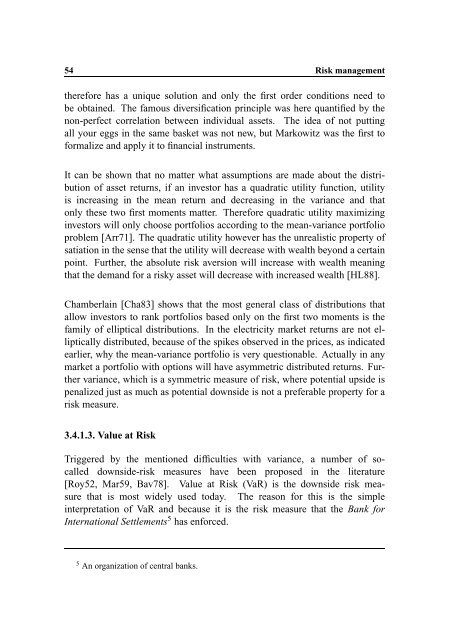Hedging Strategy and Electricity Contract Engineering - IFOR
Hedging Strategy and Electricity Contract Engineering - IFOR
Hedging Strategy and Electricity Contract Engineering - IFOR
You also want an ePaper? Increase the reach of your titles
YUMPU automatically turns print PDFs into web optimized ePapers that Google loves.
54 Risk management<br />
therefore has a unique solution <strong>and</strong> only the first order conditions need to<br />
be obtained. The famous diversification principle was here quantified by the<br />
non-perfect correlation between individual assets. The idea of not putting<br />
all your eggs in the same basket was not new, but Markowitz was the first to<br />
formalize <strong>and</strong> apply it to financial instruments.<br />
It can be shown that no matter what assumptions are made about the distribution<br />
of asset returns, if an investor has a quadratic utility function, utility<br />
is increasing in the mean return <strong>and</strong> decreasing in the variance <strong>and</strong> that<br />
only these two first moments matter. Therefore quadratic utility maximizing<br />
investors will only choose portfolios according to the mean-variance portfolio<br />
problem [Arr71]. The quadratic utility however has the unrealistic property of<br />
satiation in the sense that the utility will decrease with wealth beyond a certain<br />
point. Further, the absolute risk aversion will increase with wealth meaning<br />
that the dem<strong>and</strong> for a risky asset will decrease with increased wealth [HL88].<br />
Chamberlain [Cha83] shows that the most general class of distributions that<br />
allow investors to rank portfolios based only on the first two moments is the<br />
family of elliptical distributions. In the electricity market returns are not elliptically<br />
distributed, because of the spikes observed in the prices, as indicated<br />
earlier, why the mean-variance portfolio is very questionable. Actually in any<br />
market a portfolio with options will have asymmetric distributed returns. Further<br />
variance, which is a symmetric measure of risk, where potential upside is<br />
penalized just as much as potential downside is not a preferable property for a<br />
risk measure.<br />
3.4.1.3. Value at Risk<br />
Triggered by the mentioned difficulties with variance, a number of socalled<br />
downside-risk measures have been proposed in the literature<br />
[Roy52, Mar59, Bav78]. Value at Risk (VaR) is the downside risk measure<br />
that is most widely used today. The reason for this is the simple<br />
interpretation of VaR <strong>and</strong> because it is the risk measure that the Bank for<br />
International Settlements 5 has enforced.<br />
5 An organization of central banks.
















